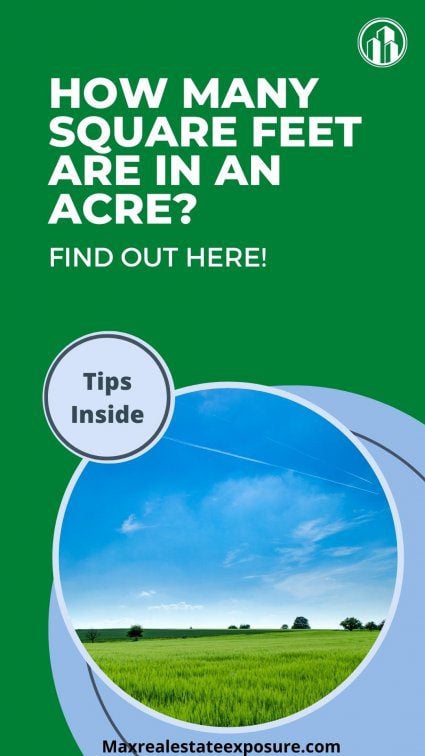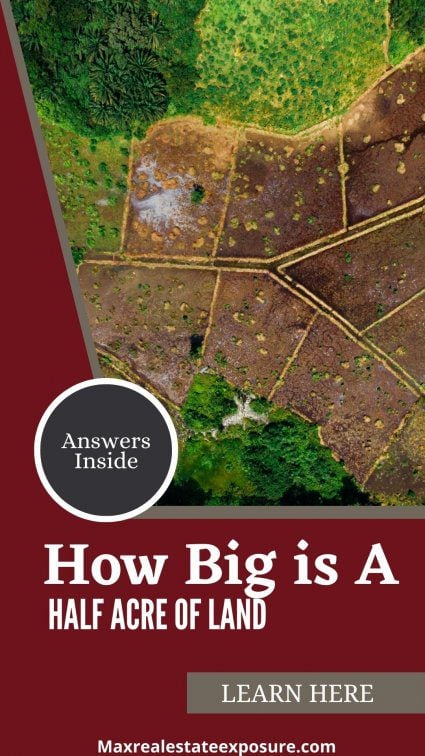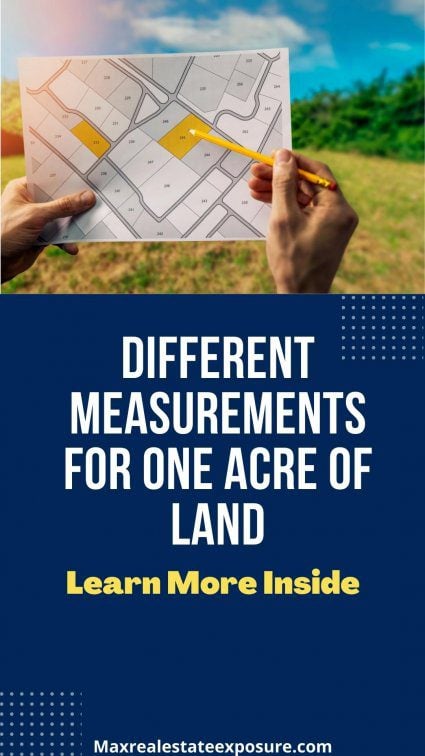
How Many Square Feet Are in an Acre?
Two questions real estate agents often get are how many square feet are in an acre and how big is an acre.
You will get in-depth answers to both questions.
A lot of people don’t know how big an acre is. Potential buyers will often ask how many square feet is in an acre because they will see the size of land posted in square feet.
When purchasing a piece of land or even a house, you must understand what you own. When looking at woods, it is sometimes challenging to visualize just how large an acre is.
Visualizing the size of a house is much easier. When someone says my house is 3000 square feet, you will probably have a pretty good idea of how large it feels. A parcel of land is much more difficult to gauge.
When Real Estate agents are asked how big an acre of land is, the answer should be second nature.
Acre square feet is one of the first things agents learn when getting their real estate license.
We will describe how big an acre is so you can better understand the size.
You may remember how much is an acre of land was already covered here in the past. You’ll be able to see how much one acre of land costs, among other things.
What is The Size of an Acre of Land?
How big is an acre?
An acre of land is 43,560 square feet. It is a land area measurement used in the United States and the United Kingdom.
One of the comparisons people often use to give folks a better understanding of how big an acre is is to compare it to an American football field. Most people have either attended a football game or watched it on television.
A football field is 48,000 square feet, not including the end zones. So, an acre of land is slightly smaller than the size of a football field.
Another way to visualize one acre of land is to consider the size of a tennis court. You can fit fifteen tennis courts into an acre.
How Many Square Feet is in an Acre of Land?
Asking how many square feet are in an acre is essential whether you are buying a house or a piece of land. It’s another way of asking how many feet are in an acre. The answer again is 43,560. The symbol or abbreviation for an acre is AC.
Land appraisers will use the size of a piece of land as one of the factors in a land appraisal. The square foot measurement of land is always used in residential appraisals.
An acre of land can also be called a US survey acre.
Understanding Acreage in Different Contexts
When exploring the concept of an acre, it’s crucial to understand its application across various contexts. An acre is a standard measurement unit in real estate, agriculture, and land planning.
However, its perception and utilization can significantly differ based on geographical location, purpose of use, and historical background. For instance, the value and appearance of an acre can vary dramatically from the vast agricultural fields in the Midwest to the densely populated urban landscapes of cities like New York or Los Angeles.
Additionally, the historical evolution of the acre from the times of oxen-plowed fields to its current legal definitions underscores the adaptability and enduring relevance of this measurement unit. By appreciating these diverse perspectives, you can better understand what an acre truly represents in today’s world.
How to Convert Square Feet to Acres?
The conversion factor for converting square feet to acres is simple. Since there are 43,560 square feet in an acre, you multiply the figure by 43,560.
Here are a few examples of square feet to acres conversions:
- 2 acres = 87,120 square feet
- 3 acres = 130,680 square feet
- 4 acres = 174,240 square feet
- 5 acres = 217,800 square feet
Using this method, you can easily calculate the total area of your land in either acres or square feet.
When converting square feet with less than an acre, the math is also easy — divide your property’s square footage area measurement by 43,560. This will give you the land area in acres.
For example, if you have a piece of land that is 30,000 square feet, you would divide it by 43,560. 30,000 divided by 43,560 is equal to .69 acres (rounded up.)
How Big is a Half Acre of Land?
 No, this isn’t a trick question. 1/2 an acre of land is 21,780 square feet. It is half the size of one acre.
No, this isn’t a trick question. 1/2 an acre of land is 21,780 square feet. It is half the size of one acre.
Half acres are usually not used to describe the size of land. The description will be done in fractional acres of land.
For example, the land area with a third of an acre would be described as having .33 acres. Residential plots are often depicted in this fashion in real estate advertisements.
How Big is a Builders Acre?
How many feet in an acre can be different when it is a builder’s acre. The term “builders acre” is different from a traditional acre. A builder’s acre equals 40,000 square feet.
You already know that an acre is 43,560 square feet, so why would there be another term known as a builder’s acre?
The term “builder’s acre” was created to simplify marketing efforts among builders and developers. The lot size is a common way to simplify the math when selling real estate.
A survey acre is approximately 10% larger than a builder’s acre. It is crucial to understand that there is a proper distinction between an acre of land and a builder’s acre of land.
Real Estate agents and builders have been sued by buyers purchasing land. The belief was that the land size was misrepresented because there was a difference between the two measurements.
You can never take for granted something even as minuscule as a slight discrepancy in land size. When asked how big an acre is, the answer should always be 43,560 square feet. Don’t confuse the size of a builder’s acre.
Representation of an acre under 43,560 square feet can get you into legal trouble.
When representing real estate, agents must be accurate in their statements to protect their clients’ investments.
Pointing out how big an acre is by showing clients suspected property lines is not wise and could lead to a lawsuit.
The only way to accurately determine lot lines is to have a licensed surveyor perform a property survey.
How Big is a Commercial Acre?
Did you know there is a difference between commercial and residential acres?
A commercial acre is a unit of land used in large cities in the United States. It is a legal unit in some US states. Measuring land in square units is customary, with a deduction for alleyways, roads, and sidewalks.
A commercial acre is about 82.6% the size of an international acre.
- One commercial acre = 36,000 square feet
- One commercial acre = 4000 square yards
- One commercial acre = 3342.8 square meters
So when someone asks how big one acre is, there is a distinction between residential, builders, and commercial acre.
The Economic Impact of Acreage on Property Value
The economic implications of acreage on property value cannot be overstated. Several factors, including location, accessibility, and potential for development, influence an acre’s worth.
An acre of land can command a significantly higher price in urban areas, where space is premium, than in rural settings. This disparity is due not only to the scarcity of land but also to the potential for commercial development, which can yield substantial returns on investment.
Furthermore, the zoning regulations and intended use of the acreage play significant roles in determining its market value. Residential, commercial, and agricultural zonings each carry different valuations and opportunities for landowners.
Understanding these economic dynamics is essential for anyone looking to invest in, develop, or sell property.
Legal Considerations and Zoning Laws
Navigating the legal landscape and zoning laws is paramount for landowners and potential buyers. Zoning regulations, which dictate the permissible uses of land within certain areas, can significantly affect an acre’s utility and value.
For example, land zoned for commercial use may have different restrictions and potential than land designated for residential or agricultural purposes. Additionally, understanding local environmental protection statutes, easements, and rights-of-way is crucial. As a realtor, I have witnessed how these factors can limit land development and usage.
I recommend prospective landowners conduct thorough due diligence, including a comprehensive land survey and legal review. This research will help ensure the acreage meets their needs and complies with all regulatory requirements.
The History of an Acre of Land
An acre is a unit of land measurement used worldwide that has undergone many changes throughout history.
The Anglo-Saxon acre was a land measurement unit still used in parts of the British Empire. It equals 1 square foot (0.093 square meters) and measures 40 feet by 4 rods.
The modern acre equals 4,840 square yards, 43,560 square feet, 4,047 square meters, and 0.4047 hectares in the imperial system of units and the US system.
An acre is a strip of land that is one furlong long by 4 rods wide.
The imperial system of weights and measures was used in the United Kingdom from 1824 until 1965 when the metric system replaced it.
These units are also part of the US Customary System, derived from the British Imperial System.
Where Did The Word “Acre” Originate?
The term acre comes from the Old English aecer, which evolved into the Middle English Aker and eventually the modern acre. Linguistics experts believe that the root word stems from the Latin word ager, which means field. This terminology makes sense when you look at how acres were initially defined.
In the middle ages, an acre was a unit of land representing the amount of land that could be plowed in one day with a pair of oxen using a wooden plow. Also called a yoke of oxen.
While the size of an acre served a purpose 1,000 years ago, the measurements of an acre vary dramatically today.
A farmer in good health can plow more in a day than a tired farmer. Rock-filled and muddy soil can also slow the plowing process, making an acre in one place smaller than an acre in a different region.
In the 13th century, Edward I of England defined an acre as 4 rods wide by 40 rods long. This standardization allowed for easy calculation of a modern acre.
Using 4 rods x 16.5 feet x (40 rods x 16.5 feet) = 66 feet x 660 feet = 43,560 feet
An acre was once a land measurement unit solidified by the Weights and Measures Acts. These acts have been recorded in England since the 10th century.
When English settlers started building in America, they used the acre as a unit of measurement. The acre is still used here and across about two dozen countries and territories wothat rldwide. isse include India and Australia, Guam, and St. Helena.
This is the history of an acre of land.
Other Measurements For One Acre of Land
 Here are some different units of measure for land size. These measurements can be used to describe the area of an acre. Have a look at the acre conversion.
Here are some different units of measure for land size. These measurements can be used to describe the area of an acre. Have a look at the acre conversion.
- How big is an acre in meters? An acre equals 4,047 square meters.
- How big is an acre in yards? One acre equals 4,840 square yards.
- How big is an acre in miles? An acre equals 1/640th of a square mile.
- How big is an acre in square inches? One acre is equal to 6,272,640 square inches.
- How big is an acre in square chains? One acre equals 9.9999600244396 square chains.
What Does One Acre of Land Look Like Visually?
It should be understood that land comes in all shapes and sizes, including when you are dealing with 1 acre.
You could have a square, a rectangle, a porkchop lot, or something unusual. The easiest way to picture an acre visually in your mind is as a square.
Given a square has the same length and width, an acre would be about 208 feet long by 208 feet wide.
You can probably visualize a 208-foot box better than some funky shape. When you don’t have a simple square, it is vital to complete a property survey to determine the lot lines accurately.
Lot Size Impacts Fair Market Value of Land
One of the factors with a home appraisal and a comparative market analysis in real estate to determine the value of land is size and usability. It can make up a significant portion of the valuation.
It is an essential factor that can often influence purchase decisions.
Lenders will also use this information when providing land loan financing. Knowing how many square feet in an acre can become vital if a property has many wetlands.
While size is essential in determining land values, if it’s not usable, it won’t have the same appeal to many people.
Common Questions About One Acre
How Many Sq Ft in an Acre?
An acre in feet is 43,560.
What is a Square Foot?
A square foot is a measurement used by the imperial and US customary systems. It is the area of a square with one-foot sides. One square foot is 144 square inches.
How Many Plots Are In One Acre?
Six plots measure sixty feet by one hundred twenty feet in one acre of land.
How Long Does it Take to Walk an Acre?
Walking speed is typically around 3 to 4 miles per hour, and a person covers 4 feet per second.
It would take you 35 seconds to cover an acre on foot, and it would take you 175 seconds to walk 5 acres if you were to walk at an average pace.
Closing Thoughts
When buying land, it is essential to understand the size of your purchase. If you have a feel for the size of one acre, it will make things more straightforward when making a purchase decision.
It is not unusual to wonder how many square feet an acre is. It is one of those questions that is often asked in buying and selling real estate.
Keep in mind the value of a parcel of land is often partially dependent on its size.
About the Author: Bill Gassett, a nationally recognized leader in his field, provided the above real estate information on how many square feet are in an acre. Bill has expertise in mortgages, financing, moving, home improvement, and general real estate.
Learn more about Bill Gassett and the publications in which he has been featured. Bill can be reached via email at billgassett@remaxexec.com or by phone at 508-625-0191. For the past 38+ years, Bill has helped people move in and out of Metrowest towns.
Are you thinking of selling your home? I am passionate about real estate and love sharing my marketing expertise!
I service Real Estate Sales in the following Metrowest MA towns: Ashland, Bellingham, Douglas, Framingham, Franklin, Grafton, Holliston, Hopkinton, Hopedale, Medway, Mendon, Milford, Millbury, Millville, Natick, Northborough, Northbridge, Shrewsbury, Southborough, Sutton, Wayland, Westborough, Whitinsville, Worcester, Upton, and Uxbridge Massachusetts.

